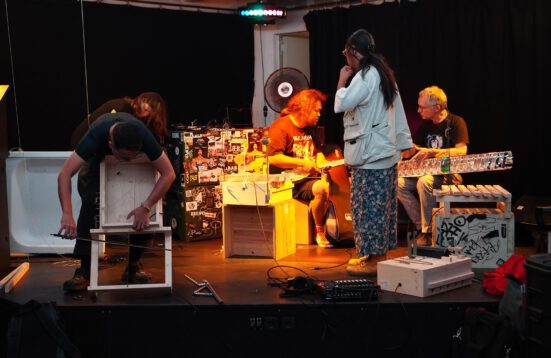Queer Sonic Fingerprint
Transdisciplinary Research
Isabel Bredenbröker and Adam Pultz
How do bodies sound? And how can a group of cultural belongings in an ethnological museum collection resonate in unexpected queer kin relations? In their interactive multichannel sound installation Queer Sonic Fingerprint, sound artist Adam Pultz and anthropologist Isabel Bredenbröker speculatively imagines non-normative relations around cultural belongings in ethnological museums and beyond. The installation amplifies the collection‘s materiality through sonic fingerprints—that is—the reflections of a body’s acoustic characteristics. In a transdisciplinary encounter with sound processing and evolutionary computing, dynamically changing fingerprints bring selected parts of museum collections to life in a multichannel sonic ecology.
Queerness contains a tension, something which gender and sexuality studies scholar Susan Talburt identifies as a fundamentally productive quality. Cultural belongings in ethnographic collections are things deeply affected by the colonial encounter and its political aftermath. They, too, are caught in a tense state, as current debates about ownership, their history, their representative functions, and proper place come to show. Voices from indigenous communities and scholars have reframed so-called ethnographic “objects” in museum collections as person-like entities. The installation includes those relations that are currently being claimed with increasing insistence, alongside relations between collection items.
The playback of the sonic fingerprints will form part of a multichannel sound installation also involving field recordings and spoken narrative. Here, kinship and relations between objects become sonic relations, contributing a different register to what is traditionally a visual experience. Museum displays and collections are governed by strict rules: most things may not be touched and many things remain inaccessible in storage. In response to such restrictions, the sonic domain can provide access through a different sensory modality. Here, imagining a sonic image of these bodies offers a sensitive way of not looking or touching, not representing or claiming ownership.
Throughout the installation the sonic fingerprints will merge, recombine, and create new generations of virtual fingerprints with their own acoustic properties, evading museal categories and representational claims, just like queer identities and ways of kinning evade normative ideas of gender, relations, and sexuality. Through evolutionary computing and audience interaction, Queer Sonic Fingerprint highlights new object-relations that transcend the logic of the museum as a place of clear-cut display, education and safekeeping. A multisensory and interactive format challenges such established forms of museal practice. Through the speculative sonic-material futures that emerge, non-normative kinship and queer narratives work toward a critique of the ethnographic collection’s colonial roots.
Isabel Bredenbröker is a social and cultural anthropologist working between art and academia. They hold a DFG Walter Benjamin Postdoctoral Fellowship which is based between the Centre for Anthropological Research on Museums and Heritage (CARMAH) and the Hermann von Helmholtz-Zentrum für Kulturtechnik at Humboldt University Berlin. Isabel’s work focusses on material and visual culture, anthropology of art and museums, queer theory and intersectionality, situatedness and autoethnography, colonialism, cleaning and waste. They have produced ethnographic films, worked with field recording and (co-)curated as well as contributed to exhibitions in museum and contemporary art contexts. Isabel’s book Rest in Plastic: Death, time and synthetic materials in a Ghanaian Ewe community has recently been published open access with Berghahn.
http://isabelbredenbroeker.com/
Adam Pultz Melbye is a double bass player, composer, and improviser working in the field of acoustic and electronic sound. Adam’s work spans live performance, sound installation, sound for dance, theatre, film, multimedia, sculpture, algorithmic design, and instrument building. They have performed and exhibited work in Europe, Australia, the US, and Japan, while appearing on close to 50 albums. Adam often performs with semi-autonomous feedback systems, such as the FAAB (feedback-actuated augmented bass). Adam holds a practice-led PhD in music technology from SARC, Queen’s University Belfast.
http://adampultz.com/









